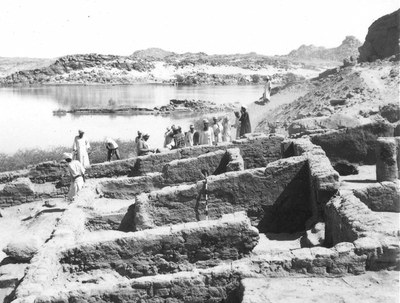Archaeology and Ancient History
The Archaeological Survey of Sudanese Nubia (ASSN) 1963-1969
 The Archaeological Survey of Sudanese Nubia (ASSN) 1963-1969 represented one of most intensive archaeological salvage programmes of the 20th century. Focussed on some 130km of the Nile valley in northern Sudan, in what was to become the southern end of the Lake Nasser/Nubia reservoir created by the Aswan High Dam, it concluded a series of archaeological surveys, initiated by George A. Reisner in 1907-11. The original fieldwork was directed by Tony Mills, on behalf of the then Sudan Antiquities Service [today the Sudan National Corporation for Antiquities and Museums- NCAM], sponsored and supported by UNESCO. This followed on the UNESCO-Sudan Antiquities Service Survey of 1960-1963 (surveying c.60km of the Nile between Faras and Gemai) undertaken by W. Y. Adams with G. J. Verwers and H.-A. Nordstrom.
The Archaeological Survey of Sudanese Nubia (ASSN) 1963-1969 represented one of most intensive archaeological salvage programmes of the 20th century. Focussed on some 130km of the Nile valley in northern Sudan, in what was to become the southern end of the Lake Nasser/Nubia reservoir created by the Aswan High Dam, it concluded a series of archaeological surveys, initiated by George A. Reisner in 1907-11. The original fieldwork was directed by Tony Mills, on behalf of the then Sudan Antiquities Service [today the Sudan National Corporation for Antiquities and Museums- NCAM], sponsored and supported by UNESCO. This followed on the UNESCO-Sudan Antiquities Service Survey of 1960-1963 (surveying c.60km of the Nile between Faras and Gemai) undertaken by W. Y. Adams with G. J. Verwers and H.-A. Nordstrom.
A primary concern of this project is to secure the publication - in varied forms - of the very extensive archives relating to the fieldwork carried out in Sudanese Nubia between 1963 and 1969. It is already very evident that there are also considerable opportunities to enhance and develop the original understandings of the fieldwork, drawing on major advances in our understandings of the archaeology of the Middle Nile since the 1960s, as well as more general disciplinary developments. The relatively recent publication of other important elements of the 1960s fieldwork also presents many further opportunities for enhancing studies of this large body of high-quality field data.
This archive represents a unique record as well as an opportunity to investigate a now-lost landscape, in potentially many varied ways. The remarkable archaeological data set (now essentially 'complete' following the inundation of the region) offers many possibilities for exploration, at many different scales and temporalities. As a region which has been colonised (in varied senses), abandoned and resettled, fought over and fought through, there are remarkably complex and entangled histories; at times forming part of the borderlands of kingdoms and empires (those of Kush, Pharaonic Egypt, Meroe, Ottoman Egypt) but also manifested in distinctive, often highly dynamic local 'Nubian' cultural forms.
A first volume, relating to the 'Pharaonic' sites recorded by the ASSN, was published in July 2020: for an introduction to these see (Edwards & Mills 2013)
Edwards, D.N. and Mills, A.J. 2020. The Archaeological Survey of Sudanese Nubia 1963-69. The Pharaonic Sites, Oxford: Archaeopress/SARS.
Edwards, D. N. 2019. ‘A possible monastery and the ‘Upper Maqs’ at Ukma-Akasha West?’, Etudes et Travaux 32, 53-79.
Edwards, D.N. 2016. ‘Among the Rocks: A first look at medieval Duweishat, from the archive’. In A. Lajtar, A.Obluski & I. Zych (eds) Aegyptus et Nubia Christiana, Warsaw: PCMA/UW, 359-380.
Edwards, D.N. and Mills, A.J. 2013. ‘Pharaonic’ Sites in the Batn al-Hajar – the ‘Archaeological Survey of Sudanese Nubia’ Revisited’, Sudan & Nubia 17, 8-17
Edwards, D. 2007. ‘Meroitic settlement landscapes in Middle Nubia’, CRIPEL 26: 59-70
This project is being directed by Dr David Edwards.